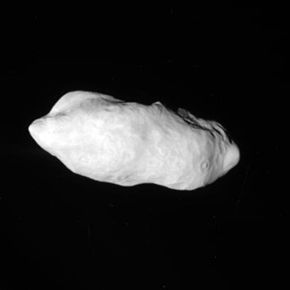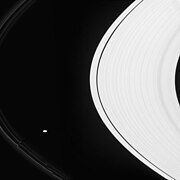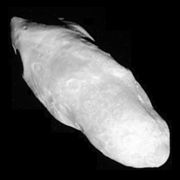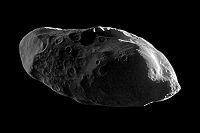Prometheus (moon)
 Prometheus image from Cassini (December 26, 2009) | |
| Discovery | |
|---|---|
| Discovered by | Stewart A. Collins D. Carlson Voyager 1 |
| Discovery date | October, 1980 |
| Designations | |
Designation | Saturn XVI |
| Pronunciation | /prəˈmiːθiːəs/[1] |
Named after | Προμηθεύς Promētheys |
| Adjectives | Promethean, -ian /prəˈmiːθiːən/[2] |
| Orbital characteristics [3] | |
| Epoch 31 December 2003 (JD 2453005.5) | |
| 139380±10 km | |
| Eccentricity | 0.0022 |
| 0.612990038 d | |
| Inclination | 0.008°±0.004° to Saturn's equator |
| Satellite of | Saturn |
| Group | Inner shepherd moon of the F Ring |
| Physical characteristics | |
| Dimensions | 137.0 × 81.0 × 56.2 km (± 1.0 × 2.8 × 0.8 km)[4]: 2 |
Mean diameter | 85.6±1.4 km[4]: 2 |
| Volume | 327740±1710 km3[5]: 4 |
| Mass | (1.59720±0.00072)×1017 kg[a] |
Mean density | 0.4873±0.0026 g/cm3[5]: 4 |
| 0.0007–0.0056 m/s2[4]: 3 | |
| 0.018 km/s at longest axis to 0.028 km/s at poles | |
| synchronous | |
| zero | |
| Albedo | 0.6 |
| Temperature | ≈ 74 K |
Prometheus /prəˈmiːθiːəs/ is an inner satellite of Saturn. It was discovered in 1980 (on October 24) from photos taken by the Voyager 1 probe, and was provisionally designated S/1980 S 27.[6]
In late 1985 it was officially named after Prometheus, a Titan in Greek mythology.[7] It is also designated Saturn XVI.[8]
Prometheus is extremely elongated, measuring approximately 137 km × 81 km × 56 km (85 mi × 50 mi × 35 mi). It has several ridges and valleys and a number of impact craters of about 20 km (12 mi) diameter are visible, but it is less cratered than nearby Pandora, Epimetheus, and Janus. From its very low density and relatively high albedo, it is likely that Prometheus is a very porous icy body. There is much uncertainty in these values, however, and so this remains to be confirmed.
Interactions with F Ring and other moons[edit]
Prometheus is a shepherd satellite for the inner edge of Saturn's narrow F Ring. Pandora orbits just outside the F Ring, and has traditionally been viewed as an outer shepherd of the ring; however, recent studies indicate that only Prometheus contributes to the confinement of the ring.[9][10]
Images from the Cassini probe show that Prometheus's gravitational influence creates kinks and knots in the F Ring as it shepherds material from it. The orbit of Prometheus appears to be chaotic, due to a series of four 121:118 mean-motion resonances with Pandora.[11] The most appreciable changes in their orbits occur approximately every 6.2 years,[3] when the periapsis of Pandora lines up with the apoapsis of Prometheus, as they approach to within approximately 1400 km. Prometheus is itself a significant perturber of Atlas, with which it is in a 53:54 mean-longitude resonance.[3]
Selected images[edit]
-
Prometheus pulling material from the F Ring
-
Prometheus tugging kinks into the F Ring
-
Voyager 2 (August 25, 1981) image
-
Cassini image (with moon's Saturn-facing end at lower right) reveals a surface covered with a blanket of fine material.
-
Image from Jan. 27, 2010. Saturnshine illuminates the moon's night side.
-
Brightened version of same image
-
Prometheus flyby
(December 6, 2015)
Animations[edit]
-
Prometheus collides with the F ring, pulls a streamer, and leaves behind a dark channel. 12 seconds 107 kbit/s
-
Movie of Prometheus and the F Ring looped once. 5 seconds 48 kbit/s
Notes[edit]
- ^ Calculated from the standard gravitational parameter GM = (1.06602±0.00048)×10−2 km3·s–2 given by Lainey et al. (2023), divided by the gravitational constant G = 6.6743×10−2 km3·kg–1·s–2.[5]
References[edit]
Citations[edit]
- ^ "Prometheus". Lexico UK English Dictionary. Oxford University Press. Archived from the original on March 20, 2020.
- ^ "Promethean". Lexico UK English Dictionary UK English Dictionary. Oxford University Press. Archived from the original on March 20, 2020.
- ^ a b c Spitale Jacobson et al. 2006.
- ^ a b c Thomas & Helfenstein 2020.
- ^ a b c Lainey et al. 2023.
- ^ IAUC 3532.
- ^ IAUC 4157.
- ^ USGS: Planet and Satellite Names and Discoverers.
- ^ Lakdawalla, E. (2014-07-05). "On the masses and motions of mini-moons: Pandora's not a "shepherd," but Prometheus still is". Planetary Society. Retrieved 2015-04-17.
- ^ Cuzzi, J. N.; Whizin, A. D.; Hogan, R. C.; Dobrovolskis, A. R.; Dones, L.; Showalter, M. R.; Colwell, J. E.; Scargle, J. D. (April 2014). "Saturn's F Ring core: Calm in the midst of chaos". Icarus. 232: 157–175. Bibcode:2014Icar..232..157C. doi:10.1016/j.icarus.2013.12.027. ISSN 0019-1035.
- ^ Renner et al. 2005.
Sources[edit]
- Marsden, Brian G. (October 31, 1980). "Satellites of Saturn" (discovery). IAU Circular. 3532. Retrieved 2011-12-29.
- Marsden, Brian G. (January 3, 1986). "Satellites of Saturn and Pluto" (naming the moon). IAU Circular. 4157. Retrieved 2011-12-29.
- Renner, Stéfan F.; Sicardy, Bruno; French, Richard G. (March 2005). "Prometheus and Pandora: Masses and orbital positions during the Cassini tour". Icarus. 174 (1): 230–240. Bibcode:2005Icar..174..230R. doi:10.1016/j.icarus.2004.09.005.
- Spitale, J. N.; Jacobson, R. A.; Porco, C. C.; Owen, W. M. Jr. (2006). "The orbits of Saturn's small satellites derived from combined historic and Cassini imaging observations". The Astronomical Journal. 132 (2): 692–710. Bibcode:2006AJ....132..692S. doi:10.1086/505206.
- Thomas, P. C. (July 2010). "Sizes, shapes, and derived properties of the saturnian satellites after the Cassini nominal mission" (PDF). Icarus. 208 (1): 395–401. Bibcode:2010Icar..208..395T. doi:10.1016/j.icarus.2010.01.025. Archived from the original (PDF) on 2018-12-23. Retrieved 2015-09-04.
- USGS/IAU (July 21, 2006). "Planet and Satellite Names and Discoverers". Gazetteer of Planetary Nomenclature. USGS Astrogeology. Retrieved 2011-12-29.
- Thomas, P. C.; Helfenstein, P. (July 2020). "The small inner satellites of Saturn: Shapes, structures and some implications". Icarus. 344: 20. Bibcode:2020Icar..34413355T. doi:10.1016/j.icarus.2019.06.016. S2CID 197474587. 113355.
- Lainey, V.; Rambaux, N.; Cooper, N.; Dahoumane, R.; Zhang, Q. (February 2023). "Characterising the interior of five inner Saturnian moons using Cassini ISS data". Astronomy & Astrophysics. 670: 6. Bibcode:2023A&A...670L..25L. doi:10.1051/0004-6361/202244757. L25.
External links[edit]
![]() Media related to Prometheus (moon) at Wikimedia Commons
Media related to Prometheus (moon) at Wikimedia Commons
- "Cassini–Huygens: Multimedia-Videos / Soft Collision". NASA. Archived from the original on 29 October 2007.
Prometheus slowly collides with the diffuse inner edge of Saturn's F ring ... pulls a streamer of material from the ring and leaves behind a dark channel.
- Prometheus Profile at NASA's Solar System Exploration site
- The Planetary Society: Prometheus
- 3-D anaglyph view of Prometheus







